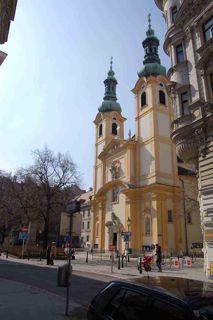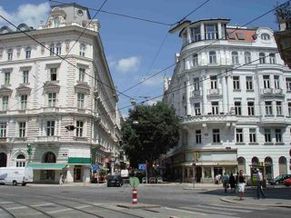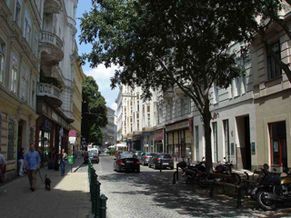One Street - 24 Houses
The Servitengasse takes it names from the Servite order, who began building a church here in 1651. The Italian mendicant order had only settled in Vienna in 1639 and the monks moved into a house in the Rossau with a stable that could be turned into a chapel. The Servite monastery was build following the purchase of a neighbouring house.
The street lies in the centre of what had been quite a Jewish neighbourhood, with a synagogue in the Müllnergasse, prayer houses in the Grünentorgasse and the Nußdorfer Strasse as well as an old people's home in the Seegasse. Until the "Anschluss" in 1938 Jewish and non-Jewish tenants were neighbours and often over half the residents of a house were Jewish.
The buildings at Servitengasse 1 and 2 form a gate-like entrance to the street, which is now mainly a residential street. A row of houses with noteworthy facades, built around the turn of the 20th century, all with shop fronts on the ground floor, stretches to the Servite monastery and the junction with the Grünentorgasse. The houses beyond this in the direction of the Pramergasse are all around 20 to 30 years older. There are a total of 24 houses in the street and their former residents were the subject of the research project "Servitengasse 1938 - The Fate of those who Disappeared".
1938
With the takeover of power by the National Socialists in March 1938, and in particular after the November pogrom, evictions become common throughout Vienna. Jewish tenants were also ordered to leave their apartments by house owners and neighbours. By law Jews had to leave their apartments by early 1939. Some found room with relatives or friends, who were themselves soon affected by the evictions, or they tried to find a place to stay in other "shared accommodation". Only a few were able to flee abroad in this situation.
In these apartments, also known as "communal apartments", Jews were crowded together. They had already been robbed of most of their property. A large number of these forced communal apartments were to be found the Serviten neighbourhood and the Rossau. Often Jews were forced to move several times between communal apartments before being ordered to go to a collection camp. From here they were taken directly to the railway station and put onto transports to the concentration camps. By the end of 1942, following the last of the big deportations from Vienna, nearly all the blocks of flats in Vienna had been declared "free of Jews".


